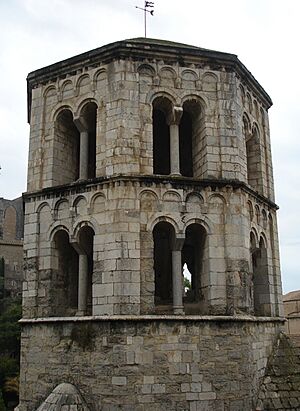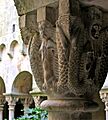Sant Pere de Galligants facts for kids
Sant Pere de Galligants is an old Benedictine monastery located in Girona, Catalonia, Spain. It's a very special place with a long history. Since 1857, this historic building has been home to the Archaeology Museum of Catalonia in the city. The name "Sant Pere de Galligants" means "Saint Peter of Galligants." The "Galligants" part refers to the River Galligants, which flows right past the monastery.
Contents
A Look Back in Time
How the Monastery Began
The monastery was built a very long time ago, in the year 992. At that time, it was located just outside the city walls of Girona. Ramon Borrell, who was the count of Barcelona, gave the monks special rights over the area around Sant Pere. The monks were in charge of this quarter until 1339. That's when King Peter IV of Aragon returned the area to the Kingdom of Aragon.
In 1117, Ramon Berenguer III, Count of Barcelona connected the monastery to Lagrasse Abbey. This other abbey was in Northern Catalonia, which is now part of France. However, Sant Pere still kept its own abbey and a lot of independence.
Changes Over the Years
Sant Pere was never a very large community of monks. The church was not the main local church for everyone in the area. Only baptisms were held there. In 1362, the monastery became part of the city when new walls were built around it. Because of this, it was redesigned to be more like a fortress.
The monastery started to become less important in the 1400s. By 1592, it was joined with two other monasteries that were also struggling: Sant Miquel de Cruïlles and Sant Miquel de Fluvià. In 1835, there was only an abbot and four monks living there. Despite its decline, the monastery was recognized as an important national monument in 1931.
The Beautiful Cloister
The monastery has a small cloister, which is an open courtyard surrounded by covered walkways. It's a great example of Romanesque architecture from Catalonia. The northern part of the cloister was built in 1154. The rest of the cloister was finished around 1190.
The tops of the columns, called capitals, have designs very similar to those found in the cloisters of Sant Cugat del Vallès or the Girona Cathedral. Some of these carvings show scenes from the life of Jesus. Others feature typical Romanesque designs, like lions or medieval-style sirens.
Exploring the Church
Church Design and Features
The Romanesque church itself was built in 1130. It has a main area called a nave, and two side aisles. It also has a transept, which is like the arms of a cross, and four rounded sections called apses. The main entrance, or portal, looks quite old-fashioned. It might have come from an earlier building. Above the entrance, there is a large round window called a rose window. It is about 3.5 meters (11.5 feet) wide.
Inside the church, you'll see many columns along the sides. The capitals on these columns have designs of plants. These columns help to support the main ceiling, or vault. The capitals on the columns in the apse areas are much more detailed. Different artists probably carved them. Some of these carvings are thought to be by a famous artist known as the Master of Cabestany.
The Bell Tower
The bell tower of Sant Pere de Galligants is shaped like an octagon, which means it has eight sides. It has two main sections. The top section has two floors, each with double arches. These arches are separated by columns. The tower is also decorated with Lombard bands, which are decorative strips of small arches.
See also
 In Spanish: Monasterio de San Pedro de Galligans para niños
In Spanish: Monasterio de San Pedro de Galligans para niños
Images for kids




